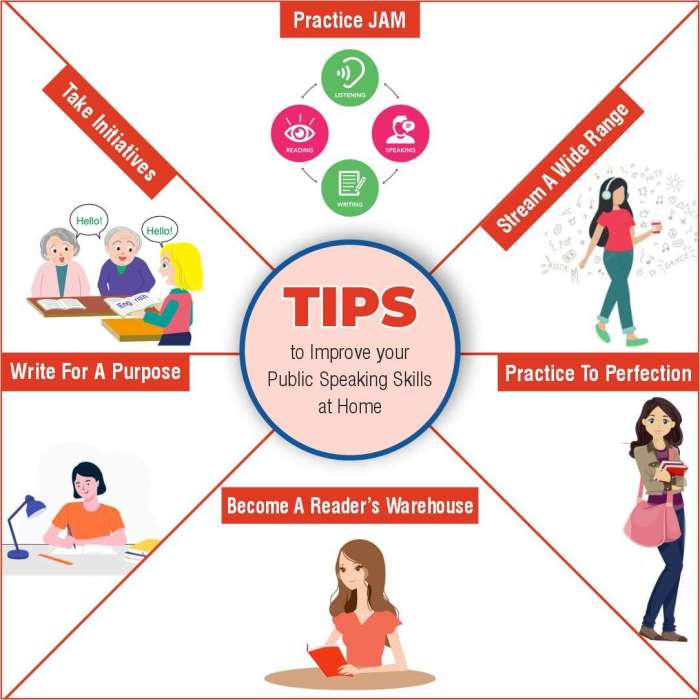Public Speaking Tips kicks off with a bang, offering insights on honing your speaking skills to captivate any audience. From overcoming nervousness to delivering impactful speeches, this guide has you covered.
Unlock the secrets to commanding attention and leaving a lasting impression with these valuable tips and techniques.
Introduction to Public Speaking Tips
Public speaking is a crucial skill that can have a significant impact on personal and professional growth. Whether you’re presenting in front of a class, pitching an idea to colleagues, or delivering a keynote speech, effective public speaking can help you communicate your message with clarity and confidence.
Benefits of Public Speaking
- Improves communication skills: Public speaking helps you articulate your thoughts clearly and persuasively.
- Boosts self-confidence: Overcoming the fear of speaking in public can enhance your self-esteem and belief in your abilities.
- Builds leadership skills: Strong public speaking abilities are often associated with effective leadership qualities.
Common Challenges in Public Speaking
- Nervousness: Many people struggle with stage fright and anxiety when speaking in front of a crowd.
- Lack of preparation: Failing to properly plan and rehearse a speech can lead to confusion and disorganization.
- Poor body language: Non-verbal cues such as posture and eye contact play a crucial role in engaging an audience.
Overcoming Fear and Nervousness
Feeling jittery before a public speaking engagement is completely normal, but there are strategies you can use to manage anxiety and boost your confidence.
Managing Anxiety Before Public Speaking
- Practice deep breathing exercises to calm your nerves.
- Visualize yourself delivering a successful speech to boost your confidence.
- Avoid caffeine and sugary foods that can increase anxiety levels.
- Prepare thoroughly and know your material inside out to feel more confident.
Building Confidence When Speaking in Front of an Audience
- Start with a strong opening to capture the audience’s attention and set the tone.
- Maintain eye contact with your audience to establish a connection and build confidence.
- Speak slowly and clearly to convey your message effectively.
- Engage the audience by asking questions or sharing personal anecdotes to feel more comfortable on stage.
Controlling Nervous Habits While Speaking
- Avoid pacing back and forth by planting your feet firmly on the ground.
- Practice good posture to exude confidence and authority.
- Avoid fidgeting with objects or excessive hand gestures that can distract the audience.
- Take pauses to collect your thoughts and breathe, allowing you to regain composure.
Preparation and Organization: Public Speaking Tips

When it comes to public speaking, preparation and organization are key factors that can make or break your speech. Properly preparing and organizing your speech content can help you deliver a clear and impactful message that resonates with your audience.
Importance of Preparing and Organizing Speech Content
Effective preparation and organization ensure that your speech flows smoothly and is easy for your audience to follow. By organizing your content in a logical manner, you can help your audience understand the main points you are trying to convey. Additionally, preparing in advance allows you to feel more confident and less nervous when delivering your speech.
- Start by outlining your main points and supporting details to create a structured framework for your speech.
- Organize your content in a way that flows naturally, such as starting with an introduction, followed by the main points, and ending with a conclusion.
- Practice your speech multiple times to ensure that you are comfortable with the material and can deliver it effectively.
Structuring a Speech for Clarity and Impact
Structuring your speech properly is crucial for ensuring that your message is clear and impactful. By following a structured format, you can engage your audience and leave a lasting impression.
- Begin with a strong opening that grabs the audience’s attention and sets the tone for your speech.
- Organize your main points in a logical order, using transitions to smoothly move from one point to the next.
- Include supporting evidence or examples to reinforce your main points and make your speech more persuasive.
Creating Engaging Openings and Memorable Closings
The opening and closing of your speech are two of the most critical parts, as they are what your audience will remember most. By creating engaging openings and memorable closings, you can make a lasting impact on your listeners.
- Use a powerful quote, surprising fact, or compelling story to start your speech and grab your audience’s attention from the start.
- End your speech with a strong closing statement that reinforces your main message and leaves a lasting impression on your audience.
- Consider incorporating a call to action or a thought-provoking question in your closing to encourage your audience to take action or reflect on what they have learned.
Delivery Techniques

In public speaking, the way you deliver your speech is just as important as the content itself. Effective delivery techniques can greatly enhance your message and engage your audience.
Body Language and Vocal Variety
Body language and vocal variety play a crucial role in public speaking. Your gestures, facial expressions, and posture can convey confidence and credibility. Similarly, varying your tone, pitch, and volume can help maintain the audience’s interest and emphasize key points.
- Use open and confident body language to appear approachable and trustworthy.
- Practice modulating your voice to emphasize important words and create a dynamic delivery.
- Avoid monotone speech by incorporating pauses, changes in pace, and vocal inflections.
Maintaining Eye Contact and Using Gestures
Maintaining eye contact with your audience helps establish a connection and shows that you are engaged and confident. Using gestures can also enhance your message and make your speech more engaging.
- Scan the room and make eye contact with different audience members to create a sense of connection.
- Use gestures that are natural and appropriate to emphasize key points or add visual interest.
- Avoid excessive or distracting gestures that can take away from your message.
Pacing, Pauses, and Emphasis
The way you pace your speech, incorporate pauses, and emphasize certain words or phrases can greatly impact how your message is received. These elements can help create a sense of rhythm and build anticipation in your audience.
- Practice varying your pace to keep the audience engaged and to emphasize important points.
- Incorporate strategic pauses to allow the audience to digest information and to build suspense.
- Emphasize key words or phrases by slightly raising your voice or pausing before or after them.
Engaging the Audience
When delivering a speech, engaging the audience is crucial to maintain their interest and ensure your message is effectively conveyed. By connecting with your audience, you create a more interactive and impactful presentation.
Strategies for Connecting with the Audience
- Start with a compelling opening: Begin your speech with a strong hook or anecdote that captures the audience’s attention from the start.
- Use storytelling: Incorporate personal stories or relevant examples to make your points more relatable and engaging.
- Ask open-ended questions: Encourage audience participation by posing thought-provoking questions that spark discussion.
Techniques for Involving the Audience
- Interactive elements: Incorporate activities, polls, or interactive exercises to keep the audience actively engaged throughout your speech.
- Visual aids: Use visual aids like slides, videos, or props to enhance your presentation and appeal to different learning styles.
- Encourage participation: Invite audience members to share their thoughts, ask for volunteers, or facilitate group discussions to involve the audience directly.
Handling Questions and Engaging in Q&A Sessions, Public Speaking Tips
- Be prepared: Anticipate potential questions and have well-thought-out answers ready to respond confidently during the Q&A session.
- Active listening: Pay attention to the questions asked by the audience, show genuine interest, and acknowledge their input to foster a productive dialogue.
- Engage all audience members: Encourage participation from different individuals in the audience to ensure a diverse range of perspectives are shared during the Q&A session.
Practice and Feedback
Practice and feedback are crucial components in improving public speaking skills. By honing your presentation through practice and receiving constructive feedback, you can enhance your delivery and connect better with your audience.
Importance of Practicing Speeches
- Regular practice helps you become more comfortable with your material, reducing nervousness and boosting confidence.
- Rehearsing allows you to refine your timing, pacing, and gestures, ensuring a smoother delivery.
- Practicing also helps you memorize your key points, making it easier to maintain eye contact with your audience.
Benefits of Receiving Feedback
- Feedback from peers or mentors provides valuable insights into your strengths and areas for improvement.
- Constructive criticism helps you identify habits or mannerisms that may distract from your message.
- Feedback allows you to make necessary adjustments and enhancements to your presentation before delivering it to a larger audience.
Tips for Improving Public Speaking Skills
- Record yourself practicing your speech to identify areas that need improvement.
- Practice in front of a mirror to observe your body language and facial expressions.
- Join a public speaking club or workshop to receive feedback from experienced speakers.
- Seek out opportunities to speak in front of small groups to gain confidence and experience.